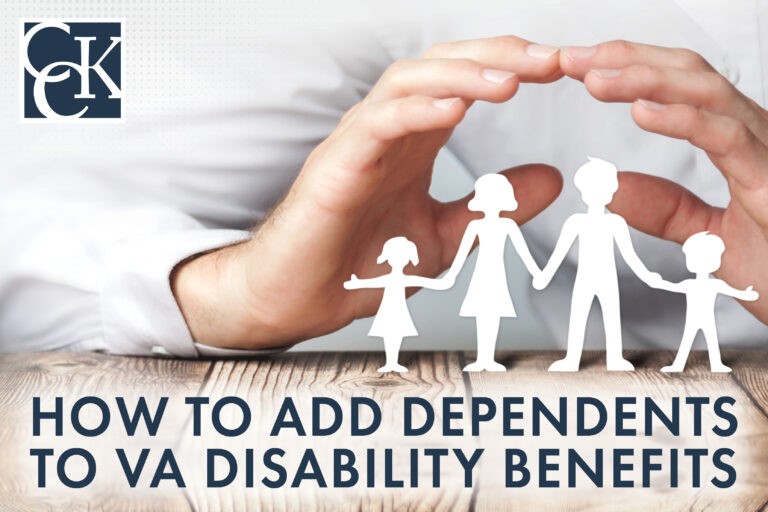How to Add Dependents to VA Disability Benefits

CCK Law: Our Vital Role in Veterans Law
VA offers benefits to veterans who are disabled as the result of their military service, and additional benefits for those that have dependents who rely on them for support. A dependent is most often a spouse or school-aged child but could also be a parent. Keep reading to learn how to add a dependent to your VA disability benefits award.
Who Does VA Classify as a Dependent?
For VA purposes, a dependent is a family member who relies on the veteran financially and meets certain criteria. Examples of dependents for VA purposes include:
- A spouse;
- Unmarried children, including stepchildren, adopted children, and biological children, who:
- Are under the age of 18; or
- Are between the ages of 18 and 23 and attending school full-time; or
- Were seriously disabled prior to reaching age 18;
- Parents in the veteran’s direct care whose net worth and income are below the limit put in place by law;
- Parents (biological, step, adopted, foster, etc.) are defined as those who, for at least one year, “stood in the relationship of a parent to a veteran at any time before their entry into active service.”
What Forms Do Veterans Need to Use to Add Dependents to their VA Benefits?
You can file a claim to add dependents to your VA benefits at the same time as when you file an initial claim for service-connected compensation. If you receive a combined disability rating of at least 30 percent, then VA will automatically consider your eligibility for additional compensation for your dependent(s).
However, if you did not apply to receive this additional compensation at the time of your original claim, then you can still add dependents at any point later on.
Importantly, if you file a claim to add dependents to your VA benefits within one year of your 30 percent combined rating grant, then the effective date of your benefit increase will be that of your original grant of benefits.
Nonetheless, there are two forms that veterans should be aware of if they are seeking to add dependents to their award: VA Form 21-686c and VA Form 21-674.
VA Form 21-686c
VA Form 21-686c, or Declaration of Status of Dependents, is a form that veterans can file to receive additional monthly compensation for qualifying dependents.

To be eligible for these benefits, veterans must have a combined disability rating of at least 30 percent.
VA Form 21-686c is a 12-page form which requests extensive information regarding the veteran’s spouse or children. Specifically, you will need to supply certain documentation to prove your relationship to the dependent.
Depending on the type of dependents (i.e., spouse of child under 18) you are adding to your VA benefits, you will fill out the following sections:
- Section I: Veteran/Claimant Identification Information;
- Section II: Information Needed to Add Spouse;
- Section IV: Veteran Reporting Divorce from Former Spouse;
- Section VI: Veteran/Claimant Reporting Death of a Dependent; and
- Section X: Beneficiary/Claimant’s Certification and Signature.
To add a spouse to your VA disability award (Section II), you will usually need to submit:
- A marriage certificate;
- A divorce decree for the spouse if the spouse was previously married;
- A divorce decree for the veteran if the veteran was previously married; and
- A death certificate if either the spouse or the veteran was previously married and their spouse passed away.
In some cases, veterans may be married to their spouse via common-law marriage. Common-law marriage is recognized in some states as a marriage without a ceremony and without registration of marriage.
VA recognizes common-law marriage if it was valid in the state that it took place, but there are other forms that need to be completed. Specifically, the veteran, as well as their spouse, will need to fill out VA Form 21-4170.
In addition, the form will need to be completed by two different people who can provide their personal observations about the veteran, their spouse, and the relationship between them at the time of the ceremony. Copies of any birth certificates for children born of the common-law marriage will also need to be provided to VA.
Adding Children to Your VA Benefits
To add a child to your VA disability award, VA typically requests:
- A copy of the child’s birth certificate; and
- A copy of the child’s social security card.
You will also most likely need information regarding the child’s school attendance. However, that documentation will be linked to VA Form 21-674.
Nonetheless, when adding children under the age of 18 to your VA benefits using VA Form 21-686c, you will use the following sections:
- Section I: Veteran/Claimant Identification Information;
- Section III: Information Needed to Add Children;
- Section VI: Veteran/Claimant Reporting Death of a Dependent;
- Section VII: Veteran/Claimant Reporting Marriage of a Child;
- Section VIII: Veteran/Claimant Reporting a Schoolchild Over 18 Has Stopped Attending School; and
- Section X: Beneficiary/Claimant’s Certification and Signature.
Importantly, Section III provides space to add up to four dependent children under the age of 18 to your VA benefits. If claiming more than four children, then veterans can fill out an addendum, found on the last page of VA Form 21-686c, and submit it along with the rest of the application. Here, veterans will provide the following information about the child being added as a dependent:
- Full name;
- Social Security number;
- Date of Birth;
- Place of Birth; and
- Child status (e.g., biological, adopted, stepchild, etc.).
Additionally, if the child does not live with the veteran, then he or she must provide the name and address of the person with whom the child resides.
If a dependent child passes away, veterans must notify VA by completing Section VI. Here, the veteran will have to provide the name of the child, the date of death, and the place of death.
If a dependent child gets married, the veteran is required to report the name of the child and the date of the marriage as he or she will no longer qualify as a dependent. This is accomplished with Section VII. The married child will then be removed from the veteran’s VA benefits.
In Section VIII, veterans must indicate the name of the school-aged child and the date in which this dependent stopped attending school. Importantly, while this form is used to notify VA of that change in dependent status and remove him or her from your benefits, it is not used to initially claim a school-aged child as a dependent. Instead, to add a child over the age of 18 who is currently attending school to your VA benefits, you must complete VA Form 21-674, Request for Approval of School Attendance.
VA Form 21-674
Form 21-674 is a form that is used to add dependents between the ages of 18 and 23 that attend school full-time. This form requires information about the veteran such as contact information and VA file number; and the school-aged dependent, such as the name and location of where they attend school and the type of education they are receiving.
The form also calls for a report of the student’s income by calendar year categorized by the source of the income (i.e., all employment, annual social security, other annuities, and all other income); how much money was received; and how much money is expected to be received the following year.
Veterans must also indicate the value of the student’s estate, broken down into savings (including cash); securities/bonds; real estate; all other assets; and the total of all of those combined.
In addition, a school transcript will likely need to be submitted in order to prove that the dependent is in school.
How to Submit Dependency Forms to VA
Once a dependency form has been completely filled out and any necessary supporting documents attached, the veteran has a few options of where to submit it.
Veterans can mail any filled-out forms, and supporting evidence, to VA’s Evidence Intake Center (PO Box 4444 in Janesville, WI 53547-4444).
When doing this, it is very important to ensure the veteran’s name is on all documents and that the envelope is addressed correctly and has a return address. This limits the risk that the veteran’s documents will be lost in the mail.
Online
Veterans can also submit forms online using VA’s online portal.
In-Person
Veterans may also submit their form in-person at a local VA Regional Office. Again, veterans should be sure to have their name on all documents being submitted.
With a Legal Representative
Legal representatives can also submit forms and evidence on behalf of the veteran. This can take away much of the stress veterans have about submitting documentation to VA. Additionally, a Veterans Service Organization (VSO) can submit the form on the veteran’s behalf.
How to Remove a Dependent from Your Benefits Award
Once a veteran has successfully been awarded dependency benefits, they will be paid a monthly amount in addition to their regular disability compensation, for the dependent. However, if there is a change in the veteran’s circumstances, such as the veteran gets divorced or their spouse passes away, then the veteran needs to remove the dependent from their benefits to avoid creating an overpayment.

This means that VA will begin to withhold money from your monthly disability check until the overpaid amount has been recuperated. If a veteran gets divorced and fails to inform VA, then VA will continue to pay the veteran additional compensation for their spouse, even though they are no longer married.
Once VA does find out the veteran is divorced, it will take back the money paid to the veteran during that time through the creation of an overpayment. As such, it is crucial to report any changes in dependents as soon as they occur.
Veterans do not need to remove children dependents from their award, as VA will do that automatically once the child turns 18 or ages out of the school-aged child range.
The same form, VA Form 21-686c, that is used to add dependents can also be used to remove dependents.
About the Author
Share this Post
